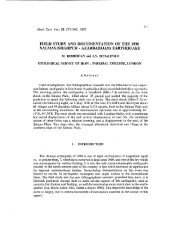PDF COPY - Manuel berberian
PDF COPY - Manuel berberian
PDF COPY - Manuel berberian
Create successful ePaper yourself
Turn your PDF publications into a flip-book with our unique Google optimized e-Paper software.
phic rocks (in the Kermanshah region only the Bisutun<br />
limestone,which was possibly deposited on oceanic islands<br />
or seamounts, is the representative of this unit).<br />
Finally the ophiolite unit, which is mainly composed of<br />
harzburgite, lherzolite, and gabbro (with some microdiorite<br />
and spilite) forms the highest part of the tectonic<br />
stack. This unit seems to be the equivalent of the Semail<br />
ophiolites of Oman and the Mina Group in the Greek<br />
Othris.<br />
The thrusting order may roughly indicate an ordered<br />
lateral transition from the Zagros continental carbonate<br />
platform in the southwest to the passive continental<br />
margin with pelagic sediments and the oceanic environment<br />
in the northeast (the High-Zagros Alpine<br />
Ocean). The radiolarite-turbidite deposition, which<br />
probably occurred at least in part on oceanic crust during<br />
the tensional and spreading phase of 200-140 Ma,<br />
ceased abruptly in the Cretaceous Period, presumably<br />
because of the effect of the compressional movements<br />
and closing processes of the High-Zagros Alpine Ocean.<br />
During ’Upper Campanian - MaastriChtian (70-65<br />
Ma)’ time, the High-Zagros ophiolite-radiolarite thrust<br />
stack in the Neyriz area is ’unconformably covered’ by<br />
the post-emplacement shallow-water reef limestone of<br />
the Tarbur Formation (Ricou 1974; Table 2). This indicates<br />
that the obduction of the ophiolites along the High-<br />
Zagros belt took place during ’late Santonian - early<br />
Campanian time (80-75 Ma). In the Kermanshah region<br />
(Brand 1978) the High-Zagros ophiolite-radiolarite belt<br />
is unconformably covered by the Paleocene volcanics<br />
and the Eocene shallow-water limestones.<br />
The High-Zagros ophiolite-radiolarite belt has a<br />
sharp tectonic boundary in the north with the adjacent<br />
Mesozoic magmatic arc of the Central Iranian active<br />
continental margin (the Sanandaj-Sirjan belt) and the<br />
Maastrichtian-Paleocene ophiolite-m61ange belt of<br />
south Central Iran (Figs. 1 and 14). Subsequent collision<br />
of Zagros and Central Iran have caused renewed<br />
southwest-directed thrusting of the High-Zagros ophiolite<br />
belt. Owing to lack of detailed work, it is not clear<br />
whether the subophiolite rocks (greenschist to amphibolite<br />
facies) of the High-Zagros, Central Iran, and the<br />
Makran region were metamorphosed during ophiolite<br />
emplacement onto the continental margin (Malpas et al.<br />
1973; Woodcock and Robertson 1977; Jamieson 1980),<br />
or formed by thrusting and related metamorphism within<br />
ocean lithosphere (Spray and Roddick 1980), or are<br />
remnant slices of older metamorphic basement. Ages<br />
found for biotite and muscovite from psammitic layers<br />
in an olistolith in the area 8 km west of Neyriz (High-<br />
Zagros belt) are 98 ± 1.2 Ma (for biotite) and 96 ±<br />
Ma (for muscovite; Haynes and Reynolds 1980) suggesting<br />
late Cretaceous compressional movements and<br />
possibly metamorphism along the High-Zagros belt.<br />
H.5.2c---Central Iran during Late Santonian time<br />
During Late Turonian (88 Ma) and Late Santonian (77<br />
BERBERIAN AND KING 245<br />
Ma) movements, Central Iran was an assembly of continental<br />
fragments and small narrow oceanic or suboceanic<br />
basins, possibly formed by back-arc spreading.<br />
Most parts of Central Iran were below sea level (shallow<br />
seas and shoals) with uneven sedimentation resulting in<br />
rapid facies and thickness changes.<br />
The Mesozoic granitic intrusions along the Sanandaj-<br />
Sirjan belt (which forms a plutonic belt along Central<br />
Iranian continental margin parallel to the High-Zagros-<br />
Oman ophiolite-radiolarite belt; Fig. 14) have been<br />
dated at 144, 80-78, and 75-65 Ma (Valizadeh and<br />
Cantagrel 1975). This presumably represents the magmatic<br />
arc formed during subduction of the High-Zagros<br />
Alpine oceanic crust (Berberian and Berberian 1980).<br />
H.5.2d--Kopeh Dagh basin during Late Turonian<br />
time<br />
Important evidence of a post-Cenomanian pre-Maas-<br />
movement was found in Takal Kuh northwest<br />
trichtian<br />
of Kopeh Dagh by Afshar Harb (1979), where the Kalat<br />
Formation (Maastfichtian) overlies unconformably various<br />
tilted horizons of the Sanganeh (Aptian-Albian)<br />
and the Aitamir Formation (Albian-Senomanian). In the<br />
west central Kopeh Dagh a disconformity is reported on<br />
top of the Abderaz Formation (Upper Turonian - Lower<br />
Senonian) and the base of the Kalat Formation (Table 2).<br />
H.5.3--Late Maasterichtian movements (65 Ma)<br />
H.5.3a--The Zagros basin<br />
The Upper Cretaceous sedimentation in most parts of<br />
the Zagros Basin usually began with neritic carbonates<br />
of the Ilam Formation (Santonian- Lower Campanian).<br />
This was followed by deeper water marls and shales of<br />
the Gurpi Formation (Campanian-Maastrichtian; Table<br />
2). During this period the northwest-southeast trend of<br />
the northwestern Zagros (Lorestan area) extended<br />
through Khuzestan and Fars, and the present Zagros<br />
trend was fully developed and established. At the end of<br />
Maastrichtian time a general regression of the sea created<br />
a major unconformity throughout the Zagros<br />
(James and Wynd 1975; Setudehnia 1978).<br />
The Mesozoic trend along the High-Zagros was destroyed<br />
after the Late Cretaceous collision of the Arabian<br />
and the Central Iranian continental crusts. The<br />
major Late Cretaceous uplift, folding, upthrusting, and<br />
erosion of the High-Zagros orogenic belt and its ophiolite-radiolarites<br />
provided the detrital material of the<br />
Upper Maastrichtian - Paleocene Amiran Flysch (James<br />
and Wynd 1965), which was deposited in a long, linear<br />
trough along the northern part of the Zagros basin (Figs.<br />
14 and 15). The flysch at some localities consists almost<br />
entirely of radiolarite and some ophiolite debris. The<br />
present scattered flysch deposits along the northern margin<br />
of the High-Zagros suggest a seaway from northwest<br />
of Makran along the present Main Zagros reverse fault<br />
line to northwestern Iran. A Late Cretaceous hiatus and







